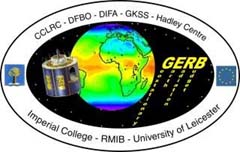Dataset
GERB-2: Level 2 averaged rectified geolocated radiance and flux data (L2arg)
Abstract
This dataset contains Level 2 averaged rectified geolocated radiance and flux data (L2arg) taken at 17 minute time resolution. Each grid point is a 3 GERB scan average weighted by the instrument point spread function.
The Geostationary Earth Radiation Budget (GERB) instrument makes accurate broadband measurements of earth leaving radiances from the geostationary METOSAT Second Generation satellites from which the emitted thermal and reflected solar components of the Earth Radiation Budget are derived. These data are available at high time resolution for the portion of the globe observable from a METEOSAT geostationary orbit above 0, 0. These data are ideal for studying fast variation in the radiation budget such as those associated with changing cloud conditions, aerosol events and the diurnal cycle. GERB 2 (METEOSAT-8) record covers the period March 2004 to April 2007. GERB 1 (METEOSAT-9) record covers the period May 2007 to January 2013.
Users must read the quality summary associated with these data and will find details of user applied correction that are recommended to be applied to these datasets before using. Please also cite Harries et al., 2005: The Geostationary Earth Radiation Budget Project, Bull. Amer. Meteorol. Soc., Vol. 86, 945-960, doi: 10.1175/BAMS-86-7-945.
The level 2 ARG (Averaged, Rectified, Geolocated) top of atmosphere radiance and flux products are averaged over three interleaved SW and TOT GERB scans. They are provided interpolated to a fixed rectified equal viewing angle grid and averaged resulting in a product with a temporal resolution of around 17 minutes. Times contained in the level 2 ARG product names indicate the nominal start of the integration period. North-south and east-west grid spacing is around 0.07° in viewing angle giving a spatial resolution of approximately 45 km at nadir. Whilst the radiances and fluxes are corrected for the spectral imperfections of the instrument, no correction is made for spatial non-uniformities in the instrument field of view response. Thus each ARG grid point is a weighted average of the observed scenes with the weighting determined by the instrument field of view response or Point Spread Function (PSF).
Details
| Previous Info: |
No news update for this record
|
|---|---|
| Previously used record identifiers: |
http://badc.nerc.ac.uk/view/badc.nerc.ac.uk__ATOM__dep_11731359365916511
|
| Access rules: |
Access to these data is available to any registered CEDA user. Please Login or Register for a CEDA account to gain access.
Use of these data is covered by the following licence(s): http://www.nationalarchives.gov.uk/doc/open-government-licence/version/3/ When using these data you must cite them correctly using the citation given on the CEDA Data Catalogue record. |
| Data lineage: |
Data collected by the GERB instrument onboard the Meteosat Second Generation satellite operated by European Organisation for the Exploitation of Meteorological Satellites (EUMETSAT), then the data processed at RMIB (Royal Meteorological Institute of Belgium) then sent to NCAS-BADC by the GERB team at Imperial College and RAL (Rutherford Appleton Laboratory). |
| Data Quality: |
Users must read the quality summary associated with these data and will find details of user applied correction that are recommended to be applied to these datasets before using.
|
| File Format: |
Data are HDF formatted
|
Related Documents
Citations: 1
The following citations have been automatically harvested from external sources associated with this resource where DOI tracking is possible. As such some citations may be missing from this list whilst others may not be accurate. Please contact the helpdesk to raise any issues to help refine these citation trackings.
| EUMETSAT & Harries, J.E. (2018) GERB-2: Level 2 High resolution (L2hr) top of atmosphere radiance and flux data. https://doi.org/10.5285/029B11F4C46A472293BC401C4B5AFDC7 https://doi.org/10.5285/029b11f4c46a472293bc401c4b5afdc7 |
Process overview
Instrument/Platform pairings
| Geostationary Earth Radiation Budget Experiment 2 (GERB-2) | Deployed on: Meteosat Second Generation 1 (MSG-1) or METEOSAT-8 |
Mobile platform operations
| Mobile Platform Operation 1 | Mobile Platform Operation for: Meteosat Second Generation 1 (MSG-1) or METEOSAT-8 |
Computation Element: 1
| Title | Meteosat Second Generation 1 (MSG-1) or METEOSAT-8 |
| Abstract | Deployed on Meteosat Second Generation 1 (MSG-1) or METEOSAT-8. |
| Input Description | None |
| Output Description | None |
| Software Reference | None |
| Output Description | None |
- long_name: Longwave Radiation
- gcmd_url: http://vocab.ndg.nerc.ac.uk/term/P141/4/GVAR0482
- gcmd_keyword: Longwave Radiation
- names: Longwave Radiation, http://vocab.ndg.nerc.ac.uk/term/P141/4/GVAR0482
- long_name: Shortwave Radiation
- gcmd_url: http://vocab.ndg.nerc.ac.uk/term/P141/4/GVAR0755
- gcmd_keyword: Shortwave Radiation
- names: Shortwave Radiation, http://vocab.ndg.nerc.ac.uk/term/P141/4/GVAR0755
Co-ordinate Variables
Temporal Range
2004-03-28T00:00:00
2007-05-10T23:00:00
Geographic Extent
60.0000° |
||
-60.0000° |
60.0000° |
|
-60.0000° |

